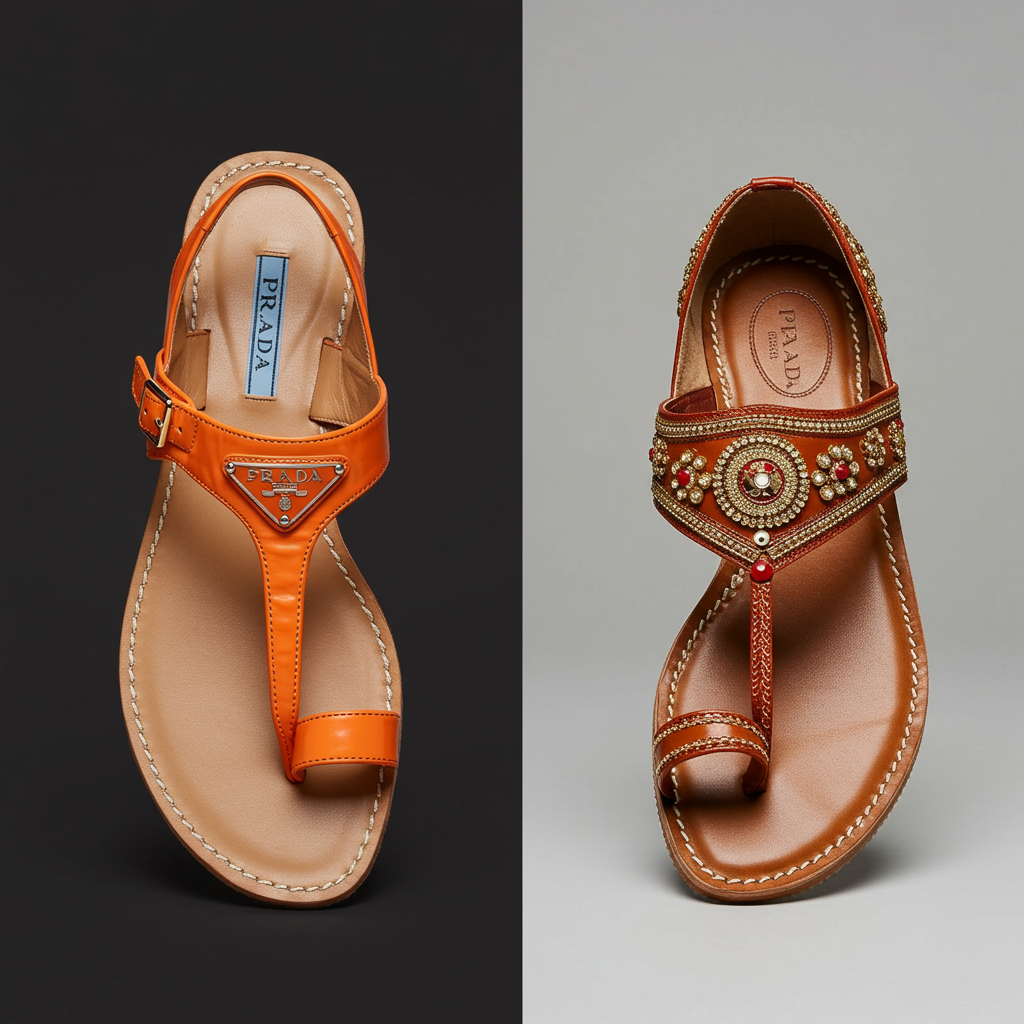A storm is brewing in the world of high fashion, placing a spotlight on the ancient craft of Indian sandal-making. When luxury giant Prada unveiled its latest footwear, the striking resemblance to traditional Kolhapuri sandals sparked outrage among artisans in Western India. Accusations of cultural appropriation and a lack of proper credit have ignited a global conversation about protecting heritage crafts and ensuring fair recognition for the communities who create them. This controversy highlights the vast disparity between the modest earnings of skilled artisans and the potential profits reaped by global brands, raising a fundamental question: when inspiration becomes imitation, who truly benefits?
The Luxury Runway Meets Traditional Craft
The controversy erupted after Prada showcased open-toe leather sandals during Milan Fashion Week for its Spring/Summer 2026 menswear collection. The designs, initially described simply as “leather sandals” in show notes, bore an undeniable likeness to the hand-stitched Kolhapuri ‘chappals’. These culturally significant sandals have been crafted in Maharashtra state for centuries. The absence of any mention acknowledging the Indian origins of the design quickly led to a significant outcry across India.
Social media platforms became a focal point for the backlash. Users, activists, and commentators swiftly accused Prada of cultural appropriation. This intense public pressure prompted Prada to issue a statement. The company acknowledged that their designs were “inspired by traditional Indian handcrafted footwear, with a centuries-old heritage.” They also indicated the collection was in early development and expressed a commitment to engaging with artisan communities for “rightful recognition.” However, for artisans who pour hours of labour into each pair, the initial omission and the stark price difference were hard to ignore. One artisan, Sadashiv Sanake, learning that Prada’s versions could fetch hundreds of pounds, scoffed and asked, “Do they have gold in them?”
Deep Roots: The Kolhapuri Sandal Story
Kolhapuri sandals boast a history stretching back to the 12th century. This traditional leather footwear originates from the town of Kolhapur in Maharashtra. For generations, the craft has been the domain of the marginalised Charmakar, or cobbler, community. Charmakar is a term historically associated with Dalits who work with animal hides.
Despite their humble origins, the craft received significant patronage in the early 20th century. Chhatrapati Shahu Maharaj, the then-ruler of Kolhapur, supported the community, allowing the craft to flourish. Each pair of authentic Kolhapuri sandals is a testament to painstaking handcrafting. Artisans like 58-year-old Sadashiv Sanake spend a full day creating just eight to ten pairs. These intricate, durable sandals typically retail locally for a mere $8 to $10.
A Struggling Industry Faces Modern Challenges
Today, the Kolhapuri sandal craft is a struggling cottage industry. Barely 5,000 artisans continue the tradition in Kolhapur. They operate in often dimly lit workshops under challenging conditions. Artisans earn low wages, some making as little as $4-5 per day, depending on orders. This lack of fair compensation is particularly prevalent among women artisans.
Women play a crucial role in the process, specifically in hand-engraving the fine patterns that adorn many designs. However, their long hours of intricate work are often undervalued. These economic realities make it difficult for the craft to compete in a mechanised world. Younger generations often choose not to follow their parents into the trade, seeking better opportunities. Kolhapur’s famous ‘chappal gully’, a street lined with sandal shops, sees many storefronts struggling to stay afloat.
Costs and Competition Mount Pressure
The challenges faced by Kolhapuri artisans extend beyond unfair compensation. Rising material costs are a major hurdle. Traditionally, cow and buffalo hide were the primary materials. However, since 2014, India has seen increased crackdowns on alleged cow slaughter, driven by religious sentiments. This has made sourcing cowhide difficult and increased the cost of buffalo leather, pushing up production expenses for artisans.
Adding to their woes is fierce competition from synthetic copies. The market is flooded with cheaper, mass-produced sandals that mimic the look of traditional Kolhapuris. Customers, seeking lower prices, often cannot distinguish between genuine leather handcrafted sandals and synthetic alternatives. This further erodes the market share and profitability for traditional artisans dedicated to preserving the authentic craft.
Seeking Protection: Legal and Ethical Battles
The Prada controversy underscores the urgent need for a robust framework to protect the rights of traditional artisans and their cultural heritage. India has taken steps domestically. In 2019, Kolhapuri sandals were granted a Geographical Indication (GI) tag. This mark protects the name and design within India, preventing unauthorized use by others domestically.
However, global protection remains elusive. There is no universally binding international law specifically preventing the aesthetic imitation of traditional crafts. While India could potentially raise the issue at the World Trade Organization under the TRIPS agreement, experts note this process is often cumbersome, expensive, and lacks strong enforceability internationally. Industry bodies are exploring options; the Maharashtra Chamber of Commerce, Industry & Agriculture (MACCIA) plans to patent the Kolhapuri sandal design, hoping to set a legal precedent.
Beyond Law: Calls for Recognition and Collaboration
Many argue that legal battles alone are insufficient. Renowned designer Ritu Beri suggests a shift towards ethical recognition. She advocates for royalty-sharing and co-branding initiatives. Beri believes that genuine respect involves fashion brands collaborating with artisans, crediting their work, and sharing profits. She notes that luxury fashion has frequently drawn inspiration from Indian crafts like Chikankari, Ikat, and mirror work without adequately crediting the artisans behind them.
The controversy has sparked mixed reactions regarding its ultimate impact. While some see potential exploitation, others believe the global attention could benefit the craft. MACCIA president Lalit Gandhi points out that Prada’s association could significantly increase the perceived value of Kolhapuri sandals globally. Local seller Rohit Balkrishna Gavali has already seen increased inquiries and orders from international clients asking for the design used by Prada. While controversy can sometimes drive interest, he emphasizes the need for this attention to translate into respect and better prices for the artisans who keep the tradition alive.
The Ongoing Dialogue
The issue is far from resolved. A plea has been filed in the Bombay High Court demanding damages and compensation for the artisans. The plea also seeks a court-supervised collaboration between Prada and artisan associations. Prada has confirmed it is in talks with MACCIA regarding the matter. A meeting between the two parties is reportedly scheduled to discuss potential paths forward. This dialogue is crucial in determining whether this high-profile case will lead to meaningful change for the Kolhapuri artisan community.
Frequently Asked Questions
What are Kolhapuri sandals and why are they significant?
Kolhapuri sandals are traditional handcrafted leather footwear originating from Kolhapur, Maharashtra, India, with roots dating back to the 12th century. They are historically made by the marginalised Charmakar community and are significant for their intricate craftsmanship and deep cultural heritage in the region. Each pair is handmade, reflecting centuries of skill passed down through generations.
What legal protections exist for traditional crafts like Kolhapuri sandals?
Within India, Kolhapuri sandals received a Geographical Indication (GI) tag in 2019, protecting their name and design nationally. However, there is no binding international law specifically against the aesthetic imitation of traditional crafts by foreign entities. Indian organizations like MACCIA are exploring options like patenting the design and potentially raising issues under international trade agreements, though these processes are often complex and challenging.
How does the Prada controversy impact Kolhapuri artisans?
The controversy has brought global attention to Kolhapuri sandals and the artisans who make them. While it sparked concerns about cultural appropriation and lack of credit, some believe it could increase global interest and demand for the authentic craft. Artisans and industry representatives hope this attention will translate into better recognition, fair compensation, and potential collaborations that allow artisans to share in the value created by their designs.
Conclusion
The dispute between Prada and Kolhapuri artisans serves as a powerful reminder of the complex relationship between global luxury markets and traditional crafts. It highlights the vulnerability of heritage skills in an era of rapid design diffusion and underscores the critical need for ethical practices, proper attribution, and fair compensation for the communities who are the custodians of these ancient traditions. As dialogues continue and legal challenges are explored, the outcome of this controversy could set an important precedent for how the fashion world interacts with cultural heritage moving forward, hopefully ensuring that the value of “gold” is recognized not just in price tags, but in the hands and history of the artisans themselves.



